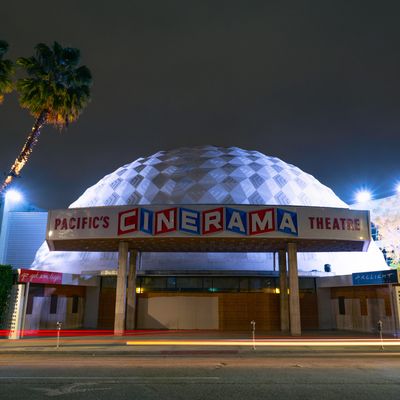
After more than a year of coronavirus-related theater shutterings, the news wasn’t exactly a surprise, but it was no less distressing. Just weeks after Los Angeles County movie theaters were cleared to reopen at 50 percent capacity, Pacific Theatres and ArcLight Cinemas announced that their more than 300 screens at 16 locations in and around L.A. were going dark for good. That includes one of the most famous movie theaters in the world: the Cinerama Dome, a Buckminster Fuller–inspired geodesic dome in Hollywood with its signature red-and-blue Googie marquee that has displayed the titles of premiering films for five decades. And local moviegoers, industry stars, and mid-century design enthusiasts are all distraught over its fate.
Designed in 1963 by Welton Becket — who also designed the cylindrical Capitol Records building a few blocks away — the Cinerama Dome was the world’s first all-concrete geodesic dome, made from 300 precast panels. Beyond its space-age glamour, rising like a cratered moon from the Sunset Boulevard sidewalk, the form carried function; the theater was engineered for films made in a special format designed to be shown on its extra-wide curved screen. Hundreds of domed Cinerama theaters were planned across the country, only a handful were built, and this is the only one left.
Owing to its iconic history and design pedigree, the Cinerama Dome was declared a historic-cultural monument by the city of Los Angeles in 1998, which means it can’t be demolished — at least, not right away. Its protected status would delay any proposed demolition or alterations for one year, says Linda Dishman, president and CEO of the Los Angeles Conservancy. But as the head of an organization that’s helped preserve dozens of local historic theaters, including many in downtown L.A., Dishman doesn’t see that happening. What does seem likely, she says, is that the property could be leased by Pacific Theatres to some entity that would continue screening films there. “This is one of the great legacy businesses — they’ve just reached the end of the line,” she says. “I think this is a good thing that people are saying this now, before they’ve made any decisions, that people are really declaring how much this place means to them.”
That legacy also includes lessons learned two decades ago, when preservationists had to save the dome from itself. Pacific Theatres was the original developer of the dome, and remarkably, it has stayed in the same company’s hands all along. But in the late 1990s, the company wanted to make major changes to modernize the site that would have dramatically altered the theater’s appearance. Pacific Theatres proposed to demolish the existing plaza, box offices, and marquee; replace the lobby with a restaurant; and eliminate the curved screen in favor of a stadium-seating layout. It was only due to advocacy from the L.A. Conservancy, and the imminent threat of a lawsuit, that the Cinerama Dome emerged practically untouched, with the newer development, featuring the ArcLight Cinemas theaters, encircling its orb with dozens of restaurants, retail stores, and the all-important parking structure.
As crestfallen fans proactively rallied on social media to “save” the theater — a petition launched this week and is well on its way to 7,500 signatures — they floated one idea that was not too far-fetched. Surely one of the streaming studios, whose business has boomed so dramatically during the pandemic, could buy it? Netflix, which just opened a gargantuan corporate campus nearby, already purchased another historic Hollywood screen, the Egyptian Theatre, last year. (It’s also leased the Paris Theater in New York, a move that almost surely kept that theater from being closed and repurposed.) The dilemma has begun to plague the preservationist movement as businesses fail in the pandemic era; special buildings need dedicated stewards (and lots of money) to stay intact. It may be that the only way to save the dome is for it to become a venue for Netflix premieres and special screenings. Bring on the Witcher marathon!

